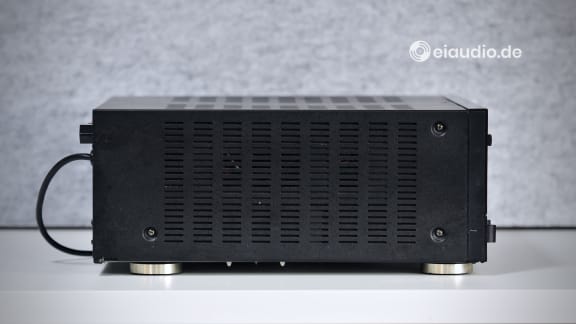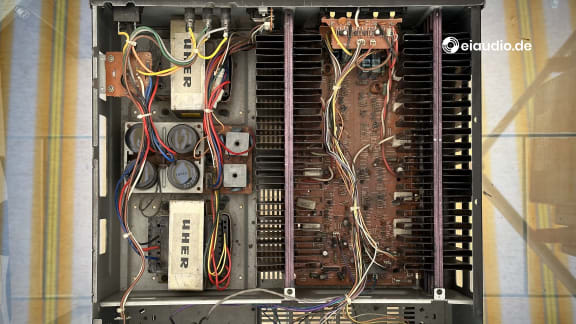Uher UMA-1000
Published: 03/07/2024
Manufacturing date: 1992
Author: Karsten Hein
Category: Gear & Review
Tag(s): Power Amplifiers
In 1993, I was 20 years old and still recovering from my family’s relocation from the city of White Plains, in the United States, to Germany’s Rhine-Main district. Despite the many re-adjustments following our move, I had managed to kindle my passion for HiFi and already purchased a DIY set of ‘transmission line’ speakers, which use a specific design to extend low-frequency response, from a now closed German manufacturer by the name of Mainhattan Acoustic in Hainburg, near Frankfurt. The owner and chief developer, Holger Müller, later went on to found ‘German Physiks’, the meanwhile world-renowned omni-directional loudspeaker company.
The ‘Fidelity 425’ was Mainhattan Acoustic’s 2nd-largest model and consisted of a 3-way bookshelf speaker that was integrated in a folded transmission line of around 2.40m length, driven by an additional 25cm paper cone woofer. Although the loudspeaker was able to produce low bass in abundance, the 4-way design’s kick bass was limited to the abilities of its 12cm midrange-to-bass driver. The foam surrounds of the two woofers, which provide flexibility but can reduce control, delivered a relatively loose interpretation of bass, rather than ultra-high accuracy, unless the speakers were driven by a very powerful amplifier.
To help me meet the speakers' power requirements, a friend of mine sold me a used Dynacord PAA 460 power amplifier with 200 Watts per channel into 8 Ohms, but the music only really picked up, when I traded this for a Dynacord PAA 880, boasting 360 Watts RMS of power output. With this beefy front end, the Fidelity 425 could make music like proper instruments. My acoustic impression of the speakers is too long ago to determine how they would compare with the audiophile standard that I am used to today, however, I do remember being asked by a neighbour, if I had invited my buddies over for a jam session the night before. An indication of how perfectly real the music had sounded to someone listening to it from the street. (Roman Groß, non-oversampling guru of the Philips CD 104, actually used to promote determining system credibility in this way.)
In our household environment, the Dynacord PA amplifier rarely needed to produce more than 5 watts of output per channel, and the aging amp soon began to develop heat-related contact issues, by which it sporadically lost output on one of the channels. The issue proved to be difficult to locate, and we ultimately decided to replace the Dynacord with a more modern HiFi amplifier. I asked around for affordable options, and a friend suggested that the American producer of audio equipment, Harman Kardon, had just started to produce a new range of affordable high-output amps bearing the brand name of Uher. The name was reminiscent of the renowned German HiFi maker of the 1950s to 1970s who by then no longer resided in Munich but had become a lingering trademark that was owned by Wolfgang Assmann GmbH in Bad Homburg.
As my friend was also interested in the new Uher design, we managed to get a 20% discount on our purchases from a local HiFi retailer. This made the already affordable amplifier even more attractive to us students. I picked up my UMA-1000 amp in Friedberg and remember being surprised by its weight. It came in at around 20kg, when boxed, which was actually not much different from weight of the professional Dynacord amplifier. I remember that it at first sounded thinner and more frail than the Dynacord had done. Little did we students know about break-in times of HiFi equipment that would have helped us make sense of the phenomenon. Therefore, I simply assumed that this was the natural consequence of moving back from professional audio to HiFi.
As the months went by, I got used to the sound of my Uher amplifier and missed the old Dynacord much less. The UMA-1000 was sounding fuller and managed to drive the Fidelity 425 quite well. In fact, the Uher became almost invisible to me. As there was nothing wrong or spectacular about it, I simply took it for granted, turning it on after school and off before going to bed. I blissfully listened to music with it, until I moved out of my parents’ house into my first student apartment in Bayreuth. On that first move, I still brought all my HiFi gear with me and asked my good friend Alexander Graham to help me carry the 35kg speakers and 18kg amp up the narrow staircase to my small 3rd floor student dorm.
When I had to move again, however, I decided that it would be easier for me to sell all my gear. And so I asked Alec, if he would be interested in buying it from me for a small price. After all, he had helped me with it so often, it was only fair to ask him first. With the Fidelity speakers and Uher amp, Alec also bought a Yamaha C4 preamp and a CD player by the same company from me. And I took the money that I received from him to Bayreuth’s ‘HiFi Point’ and reinvested it in a Denon F07 MiDi-System that came with bookshelf loudspeakers. I remember that the shop attendant looked quite sad when, during our auditioning of the system, I confessed to him that I had heard much better sound than this not long ago, when I still had my own stereo at home. This was in 1996.
After his university studies, Alec accepted a job in Hamburg and took his Yamaha, Uher, and Mainhattan Acoustic HiFi system with him. And it was not until we took our family to Marne in summer 2023 that we were living within reach of each other once again. Our first meetings were—you may have guessed it—about HiFi. While auditioning amplifiers from Symphonic Line, B&K, and Dynavox, Alec mentioned that he still had the old Uher UMA-1000 in the basement. “Good God! Bring it to me!” was my immediate reaction. A few weeks later, Alec and I were sitting on my porch cleaning the 30 year old Uher amp from layers of dust. Alec reported that he had replaced all of the speaker protection relays after they stopped responding. This was the only fault he had found with the amp over the years.
We first connected the Uher to my Tannoy system, and found that the left channel relay of ‘Speakers A’ had corroded once again and did not engage. We therefore changed the connection to ‘Speakers B’, and both channels instantly played music. The sound was tonally rich and natural, as is common for large American amps. In fact, the UMA-1000 sounded even better than I remembered it. This amplifier obviously benefitted from the meticulous setup of my system and the careful placement of the speakers. These were key factors in electro-acoustics that I had understood almost nothing about during my university years. The Uher exhibited lots of bass drive and punch, however, bass control was not on par with some of the better amps I have heard. Uher does not specify the UMA’s damping factor—the measure of an amplifier's ability to control the movement of the speaker driver—but I assume it is well below 300. Surely, a low capacitance cable, such as the Belden 9497 will help to minimise this effect.
In direct comparison with my Symphonic Line RG9 amplifier, the Uher did not sound quite as fast and agile, and some of the nuance in the treble was missing despite using my most capable of Cinch/RCA cables in the setup. Piano notes sounded slightly less piercing, and Nick Cave’s boyish charm could easily go unnoticed. However, this effect was much less pronounced than it was found on many other amplifiers, including the far more famous, elaborate, and expensive Harman Kardon ‘Citation 21’. I could not help but grin at how well I had chosen my amp so many years ago. The Uher’s dual transformers, large supply caps, and fully-symmetrical design gave it great energy reserves and made it sound large, precise, and effortless. The truth is, without comparing it directly to amplifiers costing many times its price, I could see myself once again being quite happy with this machine.
From what I can see today, Harman/Uher kept their promise of delivering a high quality product at an entry level price. The UMA-1000 was the smallest amp of the UMA series and is living proof of this philosophy. After some hours of operation at living room volumes, I checked the cabinet temperature and found that the amp had hardly run warm above its internal heat sinks. Our 8 Ohms Tannoys were an easy load to drive for the Uher's six output transistors per channel. Uher sets the minimum load requirement at 4 Ohms, which could mean that the amp will run into protection when faced with difficult loads at high volumes. From the temperature reading above the heatsinks, however, I would have no problem connecting the UMA-1000 to our Martin Logan speakers and to drive them at moderate volumes.
Listening to the Uher UMA-1000 again after all these years, I’m reminded of the simple joy it brought to my early HiFi days. Its sound isn’t perfect by today’s standards, but there’s an honesty in its delivery that modern amplifiers often lack. The UMA-1000 may not dazzle with high-tech specs, but it does something more important—it connects me to the music in a way that feels personal and timeless. This amplifier has proven that quality, in the right context, truly does endure.
Specifications
- Type: solid state stereo power amplifier
- Principle: Dual transformer, symmetrical
- Power consumption: 1,000 watts (max.)
- Power output (8 Ohms): 2x 150 Watts, RMS
- Power output (4 Ohms): 2x 220 Watts, RMS
- Dynamic output (4 Ohms): 2x 400 watts
- Frequency range: 3 - 120,000 Hz -3 dB
- Total harmonic distortion: <0.01%
- Signal to noise ratio: 110 dB
- Damping factor: N.N.
- Line input(s): 1x stereo, cinch/RCA,
- Line input sensitivity: 1 V / 50 kOhms
- Speaker terminals: 2x stereo (=A/+B)
- Dimensions: (W)435 x (H)180 x (D)410 mm
- Unit weight: 18.5 kg
- Country of manufacture: South Korea
- Year(s) 1992 - 1994





